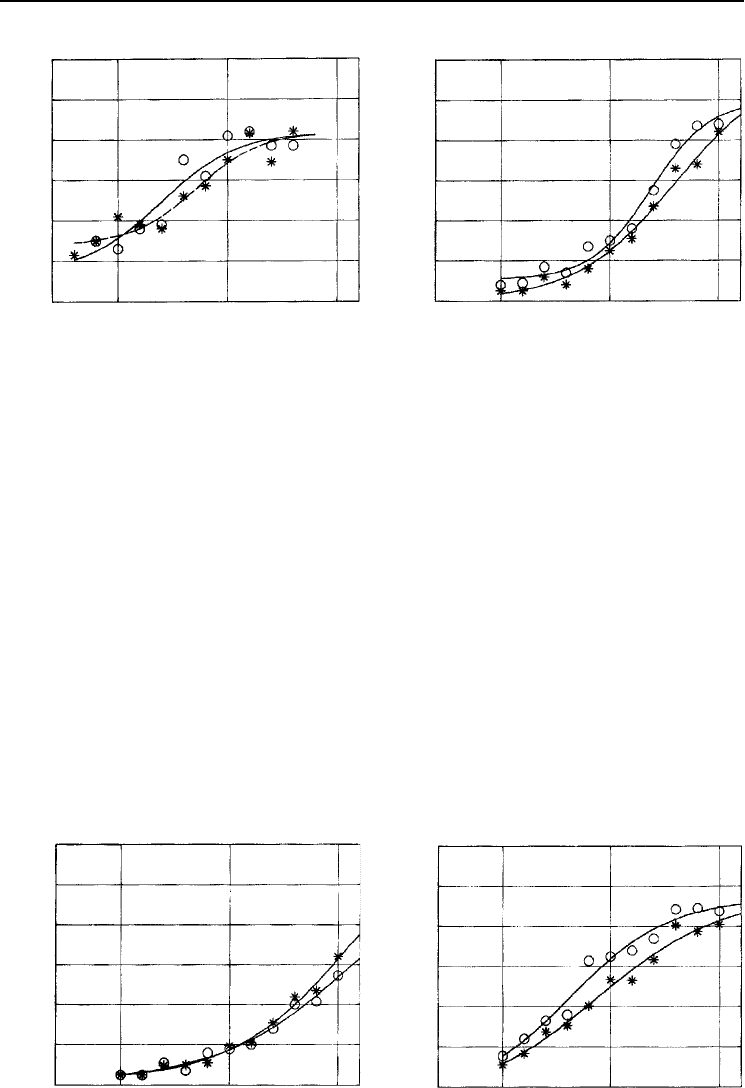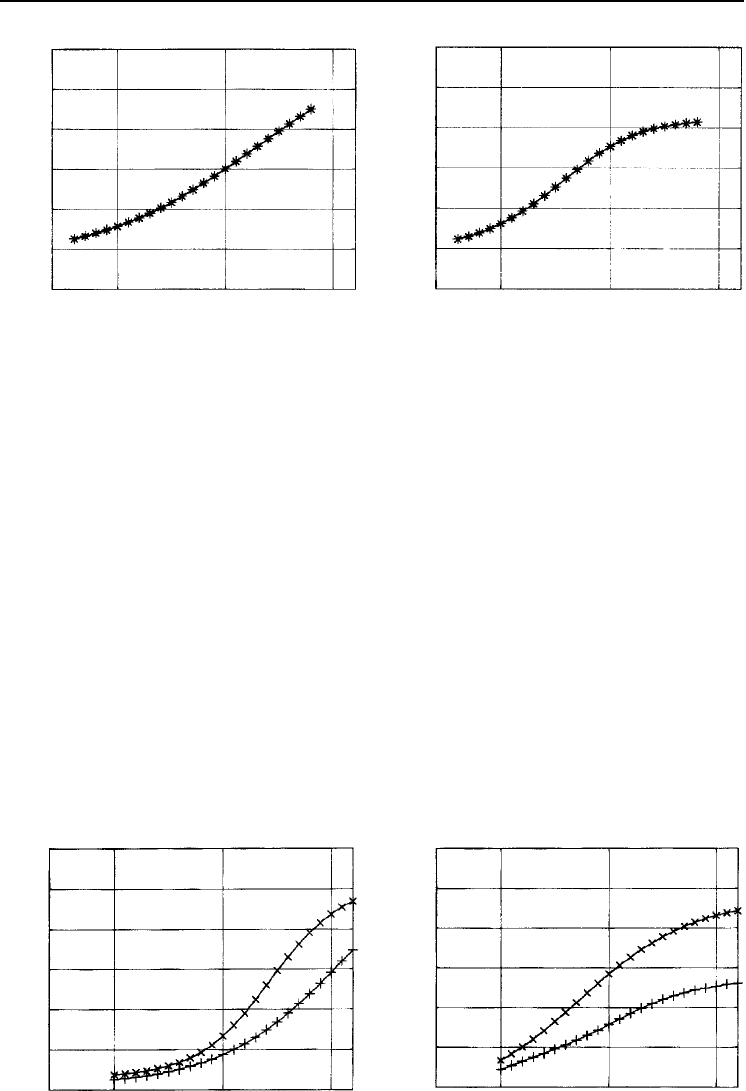Amaro A., Reed D., Soares P. (editors) Modelling Forest Systems
Подождите немного. Документ загружается.


24Amaro Forests - Chap 21 1/8/03 11:53 am Page 246
246 N. Picard et al.
group. This approach is quite general and could be applied to several types of
models.
In the case of the Paracou forest, the matrix model based on process-specific
gr
oups does not yield better short-run (6 years) predictions after disturbance than
the classical matrix model based on comprehensive species groups. This raises ques-
tions about: (i) the construction of the species groups, and (ii) the estimation of the
model parameters.
First, species groups could be built from parameters other than the ones that we
used. The parameter
α
0
can be interpreted as the diameter growth rate in an empty
plot (when b = 0), whereas
α
1
represents the sensitivity of the diameter growth rate
to the plot stocking. Similarly,
β
0
represents the recruitment rate for an empty plot
and
β
1
represents the sensitivity of the recruitment to the plot stocking. A cluster
analysis based on (
α
0
,
α
1
) (or on (
β
0
,
β
1
)) thus favours species groups that behave
similarly in large openings and have a similar sensitivity to the stocking. However
no empty plot (b = 0) is observed at Paracou, and
α
and
β
0
result from an extrapola-
0
tion. It may be safer to use parameters that correspond to situations that are
observed at Paracou. In particular the cluster analysis could be based on (
α
0
α
1
,
α
1
) or (
β
0
β
1
,
β
1
), where
α
0
α
1
represents the diameter growth rate in the station-
ary state (b = 1) and
β
0
β
1
represents the recruitment rate in the stationary state.
Species groups that are homogeneous with respect to
α
0
α
1
or
β
0
β
1
are then
more likely to make accurate predictions of the stationary state (or long-run predic-
tions) than species groups based on
α
0
or
β
0
. Moreover, expert knowledge of the
autecological traits of the Guyanese species should be consulted to validate the
species groups that are obtained with the cluster analysis.
Secondly, the parameter estimation is a more delicate step for the model with
shifting species gr
oups than for the classical models based on fixed species groups.
In the classical approach, a change in a parameter of a given species group only
affects this group. The model predictions for a group can then be used to detect
anomalous parameter values and correct them. With shifting species groups, the
change in a parameter will affect several groups. All the 43 species groups that we
obtained at Paracou are interconnected through their parameters: a species group
with its parameters cannot be isolated and treated separately from the other groups.
As a consequence, a diagnosis of anomalous parameter values from the model pre-
dictions is much more difficult. The interconnection between parameters could,
however, be investigated with an elasticity analysis (de Kroon et al., 1986) by com-
puting quantities such as
∂
ln P /
∂
ln p
s
where P
s
is the predicted number of trees
s
or basal area of species group s, and p
s
is one of the model parameters relative to
group s.
Eventually, to deal with the different weights of the subplots in regressions 4
and 5, one could r
eplace regressions 4 and 5 by a two-stage weighted least-square
regression (Anderson et al., 1985). The first stage would be identical to the longitudi-
nal data regression that is described in this chapter and would yield initial esti-
mated uˆ
sint
and qˆ
sint
. The second stage would be a longitudinal data regression with
the following variance–covariance structure:
Cov
ε ε
sin si n t t
nn i i t t , , ,
′′
( )
= ≠
′
≠
′
∀
′
( )
0if or
(8)
Cov
ε ε σ σ ρ
sin sin sin sint t t t s
tt
,
ˆ ˆ
′ ′
−
′
( )
=
(9)
where
σ
= uˆ
sint
(1
uˆ
sint
)/N
sint
for regression 4,
σ
= qˆ
sint
(1
qˆ
sint
)/N
sint
for regres-ˆ
sint
ˆ
sint
sion 5, and N
sint
is the observed number of trees of species group s in diameter class i
and subplot n at year t. The latter relationships follow from the fact that the num-
bers of trees of species group s in diameter class i and subplot n that remain in the

24Amaro Forests - Chap 21 1/8/03 11:53 am Page 247
247 Process-dependent Groups for Modelling
same class, grow up or die follow a multinomial law with parameters (N
sint
, p
sint
,
u
sint
, q
sint
).
In conclusion, the use of shifting species groups in models of forest dynamics
of
fers a greater richness of modelled species behaviours, without an increase of the
number of parameters of the model. However it raises specific problems for model
correction that would warrant further investigation.
Acknowledgements
We thank two reviewers for their helpful comments on an earlier version of the
manuscript.
References
Anderson, D.R., Burnham, K.P. and Crain, B.R. (1985) Estimating population size and density
using line transect sampling. Biometrical Journal 27, 723–731.
Boscolo, M. and Vincent, J.R. (1998) Promoting Better Logging Practices in Tropical Forests: a
Simulation Analysis of Alternative Regulations. Development Discussion Paper 652, The
Harvard Institute for International Development, Harvard University, Cambridge,
Massachusetts.
Buongiorno, J. and Michie, B.R. (1980) A matrix model of uneven-aged forest management.
Forest Science 26, 609–625.
de Kroon, H., Plaisier, A., van Groenendael, J. and Caswell, H. (1986) Elasticity: the relative
contribution of demographic parameters to population growth rate. Ecology 67,
1427–1431.
Diggle, P.J., Liang, K.Y. and Zeger, S.L. (1996) Analysis of Longitudinal Data. Oxford Statistical
Science Series No. 13, Clarendon Press, Oxford, 253 pp.
Favrichon, V. (1998) Modeling the dynamics and species composition of tropical mixed-species
uneven-aged natural forest: effects of alternative cutting regimes. Forest Science 44,
113–124.
Finegan, B., Camacho, M. and Zamora, N. (1999) Diameter increment patterns among 106 tree
species in a logged and silviculturally treated Costa Rican rain forest. Forest Ecology and
Management 121(3), 159–176.
Houde, L. and Ledoux, H. (1995) Modélisation en forêt naturelle: stabilité du peuplement. Bois
et Forêts des Tropiques 245(3), 21–26.
Huth, A. and Ditzer, T. (2001) Long-term impacts of logging in a tropical rain forest: a simula-
tion study. Forest Ecology and Management 142(1–3), 33–51.
Köhler, P. and Huth, A. (1998) The effects of tree species grouping in tropical rainforest mod-
elling: simulations with the individual-based model Formind. Ecological Modelling 109,
301–321.
Köhler, P., Ditzer, T. and Huth, A. (2000) Concepts for the aggregation of tropical tree species
into functional types and the application to Sabah’s lowland rain forests. Journal of Tropical
Ecology 16, 591–602.
Köhler, P., Ditzer, T., Ong, R.C. and Huth, A. (2001) Comparison of measured and modelled
growth on permanent plots in Sabahs rain forests. Forest Ecology and Management 144(1–3),
101–111.
Schmitt, L. and Bariteau, M. (1990) Gestion de l’écosystème forestier guyanais: etude de la
croissance et de la régénération naturelle – Dispositif de Paracou. Bois et Forêts des
Tropiques 220, 3–23.
Shugart, H.H., Hopkins, M.S., Burgess, I.P. and Mortlock, A.T. (1980) The development of a
succession model for subtropical rain forest and its application to assess the effects of tim-
ber harvest at Wiangaree State Forest, New South Wales. Journal of Environmental
Management 11, 243–265.

24Amaro Forests - Chap 21 1/8/03 11:53 am Page 248
248 N. Picard et al.
Usher, M.B. (1969) A matrix model for forest management. Biometrics 25, 309–315.
Vanclay, J.K. (1989) A growth model for north Queensland rainforests. Forest Ecology and
Management 27(3–4), 245–271.
Wan Razali, B.W.M. (1986) Development of a generalized forest growth and yield modelling
system for mixed tropical forests of peninsular Malaysia. PhD thesis, University of
Washington.

25Amaro Forests - Chap 22 25/7/03 2:06 pm Page 249
22 Modelling Current Annual Height
Increment of Young Douglas-fir
Stands at Different Sites
Pero J. Radonja,
1
Milos J. Koprivica
1
and
Vera S. Lavadinovic
1
Abstract
Generally, modelling the non-linear and complex process of current annual height increment of
any timber species is significant both in dendrometric studies and in practical forest exploita-
tion. Using the methods of artificial intelligence based on neural networks, we attempted to
extract the non-linear process of height increment from the observed data sets and to generate
a prediction as accurately as possible. The first part of the chapter analyses height increment of
different provenances of young Douglas-fir (Pseudotsuga menziesii (Mirb.) Franco) stands at dif-
ferent sites. After that, the corresponding data-based models of height increment are evalu-
ated. The models of suitable sites, standard sites and unsuitable sites for Douglas-fir fast
growth and development, as well as the models for superior provenances and inferior prove-
nances, are proposed.
Introduction
Forest models can be used as very successful research and management tools. The
models designed for research require many complicated and not readily available
data, whereas the models designed for management use simpler and more readily
accessible data (Johnsen et al., 2001). On the other hand, forest models are commonly
divided into process-based and empirical.
Process-based models have intellectual and scientific advantages compared
with empirical models. Pr
ocess models deal with deep scientific understanding of
the considered processes and are associated with a large number of analysed
processes, in the case of statistical models. However, in spite of that, some
researchers believe that process models will never be of practical use (Zeide, 1997).
On the other hand, all models used in forest management are data-based or
empirical. In our opinion, the pr
ocess-based models are a very good basis for under-
standing the acquired data, i.e. for understanding the physiological and ecological
sides of a number of processes in forestry. Note that measurement data, in fact, inte-
grate all relevant physiological processes, including those still unknown to us.
1
SE Serbiaforest, Institute of Forestry, Yugoslavia
Correspondence to: inszasum@EUnet.yu
© CAB International 2003. Modelling Forest Systems (eds A. Amaro, D. Reed and P. Soares) 249

25Amaro Forests - Chap 22 25/7/03 2:06 pm Page 250
250 P.J. Radonja et al.
It is known that increased complexity of a model reduces the generality of the
considered model. Because of that, we shall omit the analyses of climate factors
(Zhang et al., 2000) The reduced model is based on the widely used assumption that
the relationship between height increment and age of dominant trees depends solely
on global site properties (Baldwin et al., 2001).
Based on multiannual measurements, this chapter presents the results of
r
esearch on young Douglas-fir stand development at different sites. More precisely,
we present the analyses and modelling of current annual height increment of young
Douglas-fir stands of different provenances at different sites. Ten different sites were
analysed in Serbia: Jelova Gora, Goc, Kosmaj, Jastrebac, Bogovadja, Majdanpek,
Zlatibor, Crnoljeva Mt. (Vrcelj-Kitic, 1982), Tanda (in eastern Serbia, near the town
Bor) and Juhor (in central Serbia) (Lavadinovic, 1995), and four provenances, Nos
03, 09, 17 and 30 (Lavadinovic and Koprivica, 1996, 1997). The models were gener-
ated by averaging individual models obtained for different locations (sites).
Analysis of Height Increment of Young Douglas-fir Stands at Different Sites
One of the best indicators of site properties and provenance success is the value of
current annual height increment. However, unfortunately, the ages of the study
stands are insufficient to determine the years of culmination and the maximum val-
ues of height increment.
Figure 22.1 illustrates the measured data and curves of height increment in the
sample plots on Goc, data denoted by ‘x’, and Jelova Gora, data denoted by ‘+’. The
sample plot on Goc is at an altitude of 400
–500 m. The altitude of stands on Jelova
Gora is about 950 m. It can be seen that the development of Douglas-fir stands on
Jelova Gora is slower, which is correct. The slower development results from the
higher altitude of stands on Jelova Gora (Stamenkovic and Vuckovic, 1988). The
sites on Mt Goc and Jelova Gora can be considered to be very favourable for
Douglas-fir development and introduction.
Figure 22.2 presents the curves of height increment and measured data of sam-
ple plots on Kosmaj (dashed line and ‘*’), and sample plots on Jastr
ebac (solid line
and ‘o’). The altitudes of sample plots of Kosmaj and Jastrebac are 300 and 700 m,
respectively. In spite of that, the increment at the age of 12 years on Jatrebac is some-
Predic.: Goc (x)–Jelova gora (+)
120
100
80
60
40
20
0
Increment (cm)
5
Predic.: Kosmaj (*)–Jastrebac (o)
120
100
80
60
40
20
0
Increment (cm)
5
10 15
10 15
Age (years)
Age (years)
Fig. 22.1. Curv
es of height increment and the Fig. 22.2. Curves of height increment and the
corresponding data. corresponding data.

25Amaro Forests - Chap 22 25/7/03 2:06 pm Page 251
251 Modelling Current Annual Height Increment
what greater than on Kosmaj. Unfortunately we do not have the measurement at
age 13 years for Kosmaj. In the considered age period particularly from 5 to 12
years, the curves of height increment for the stands on Kosmaj and Jastrebac are
very similar. The sites on Kosmaj and Jastrebac can be considered as standard sites
for Douglas-fir cultivation and development.
Note that fitting and prediction of all measured data in this chapter are per-
formed using a method of artificial intelligence. The fitting and pr
ediction are also
performed by two-layer neural networks. The application of neural networks will be
further explained in a later section of this chapter.
Figure 22.3 shows the measured data and the height increment curves for the
sites at Bogovadja (‘*’ and dashed line) and Majdanpek (‘o’ and solid line). The vari-
ations in the height incr
ement due to climate factor variation are very great. It is
known that the effects of the climate factors are greater on the more unsuitable sites.
Based on Fig. 22.3 we can say that the culmination of height increments for
Bogovadja and Majdanpek will probably be after the age of 15 years and will
amount to about 80 cm. For example: the culmination of height increment on loca-
tion Goc (Fig. 22.1) will be probably at about the age of 15 years and about 130 cm.
Because of the unfavourable conditions for Douglas-fir cultivation at Bogovadja and
Majdanpek, it is very difficult to define the model for these sites.
Analysis of Height Increment of Young Douglas-fir Stands at Tanda and Juhor
This section presents the results from the sample plot Tanda in eastern Serbia and
the sample plot Juhor in central Serbia. As has been stated, a good indicator of site
properties and provenance success is the value of height increment. Because of that,
we also deal with height increment in this section. Note that all the measurements
were taken at the end of the vegetation period each year.
The geographical position of the sample plot Tanda is 44° 14 N, 22° 09
E. Its
altitude is 370 m, exposure south-east, on a site of Hungarian oak and Turkey oak
(Quercetum farnetto-cerris Rud.). Parent rock is granite, and the soil is acid brown,
shallow, sandy and moderately dry. Douglas-fir seed was obtained via the FAO,
and collected by the Center of Forest Seed in Mackon, USA (Lavadinovic and
Koprivica, 1997).
The measured data and the corresponding height increment curves for the
pr
ovenances with the greatest height increment (Nos 03 and 30) are presented in
Fig. 22.4. It can be seen that the increment value is about 90 cm at the age of 16
years. The measurement data and the curves of height increment of the least
favourable provenances (Nos 09 and 17) are shown in Fig. 22.5.
The sample plot Juhor is situated between 43° 47 and 43° 55
N and between
18° 52 and 18° 58 E, at an altitude of 660–700 m, on a beech site (Acetum submon-
tanum Jov.) (Lavadinovic and Koprivica, 1996).
The more successful provenances (03 and 30, see Fig. 22.6), have a greater height
incr
ement than the provenances 09 and 17 (Fig. 22.7), at the location Juhor. In general,
there are difficulties in comparing the Tanda and Juhor sites. To illustrate this, the
height increments for the best and worst provenances at the age of 10 years on Juhor
have values of 60 and 30 cm, respectively. The corresponding values at Tanda are
only 30 and 20 cm, respectively. However, at age 15 years, the height increments for
the worst provenances on Tanda are greater (55–65 cm) than on Juhor (45–60 cm).
As we have seen, the best results for height increment on a beech site (A. sub-
montanum Jov
.) in Serbia were obtained in the provenances Nos 03 and 30, and the
worst were Nos 09 and 17. The common characteristic of the best provenances is

25Amaro Forests - Chap 22 25/7/03 2:06 pm Page 252
252 P.J. Radonja et al.
Predic.: Bogovadja (*)–Majdanpek (o)
120
100
80
60
40
20
0
Increment (cm)
120
100
80
60
40
20
0
Increment (cm)
Tanda-Prov. 03 (o) and 30 (*)
5 10 15 5 10 15
Age (years) Age (years)
Fig. 22.3. Curv
es of height increment and the Fig. 22.4. Current annual height increment.
corresponding data.
that they originate from an altitude between 300 and 450 m, latitude between 45°
and 47° 7 and longitude between 122° 4 and 123° 8. As the study stands grow at
an altitude of about 700 m, in the case of stands on Juhor, it seems that the altitude
was the decisive factor in that case.
It is known that inferior provenances are more sensitive to altitude than supe-
rior pr
ovenances. Because of that, height increment at the age of 15 years, for the
provenances 09 and 17 (Fig. 22.5) at the site Tanda, which was about 60 cm, differs
from the increment at the site Juhor, which was about 50 cm (Fig. 22.7). For the good
provenances (Nos 03 and 30), height increment was practically the same, about
90 cm, both at Tanda and at Juhor (Figs 22.4 and 22.6, respectively).
Modeling Based on Neural Networks
The modelling of current annual height increment, in the conditions of different
sites, is difficult to implement using traditional linear or non-linear regression
approaches. With the recent advances in the technology of artificial neural networks
Tanda-Prov. 09 (o) and 17 (*) Juhor-Prov. 03 (o) and 30 (*)
120
100
80
60
40
20
0
Increment (cm)
120
100
80
60
40
20
0
Increment (cm)
5 10 15 5 10 15
Age (years) Age (years)
Fig. 22.6. Current annual height increment
Fig. 22.5. Current annual height increment.
provenances Nos 03 and 30.

25Amaro Forests - Chap 22 25/7/03 2:06 pm Page 253
253 Modelling Current Annual Height Increment
(ANN; Haykin, 1994), it is now possible to develop very successful non-linear ANN
models to examine complex increment–age relationships. Note that the problem of
generating the model which represents the increment–age relationship for a study
site (location) is in fact, in the simplest case, a problem of curve fitting. However, the
application of neural networks (NN) provides important advantages of experiential
knowledge acquisition. Because of that, NN are able to extract a non-linear model
from the observed data sets and to generate predictions more easily than non-linear
regression approaches.
Generalization is the major attractive property of NN. The generalization is to
use information that NN have collected during the training period in or
der to syn-
thesize input–output mapping with novel data. The small mean squared error of the
obtained model with test data means that the good generalization capability is
achieved. Note that the very accurate approximation of a function class can lead to
poor generalization capability (Haykin, 1994).
In our case, we can make predictions using the trained neural network. The
training or learning of NN is performed by measur
ed data.
The main difficulty of applying NN techniques in many scientific areas is the
pr
oblem of over-learning and losing the ability to generalize. The common proce-
dures followed to avoid over-learning mainly include adding a priori knowledge
into the model through, for example, reducing the size of the neural network by
decreasing the number of neurons in the hidden layer or stopping the training
process early (Haykin, 1994; Zhang et al., 2000). The early stopping of the learning or
training process can be realized by increasing the sum-squared goal error or simply
by decreasing the maximum number of epochs to train.
The best model of the considered non-linear biological process is obtained
when a two-layer NN, based on the Levenber
g–Marquardt algorithm, is used (NN
Toolbox, 2000). The commonly used activation (or transfer) functions are linear
functions for output neurons, or for neurons in the output layer, and logistic sig-
moid functions for hidden neurons or for neurons in the hidden layer (Zhang et al.,
2000). In the cases studied, one neuron in the output layer and 1–2 neurons in the
hidden layer are used. The process of learning and the obtained error of modelling
in the case of application of one neuron in the output layer and two neurons in the
hidden layer are presented in Figs 22.8 and 22.9, respectively.
Note that, in the case when we use only one neuron in the hidden layer, the risk
of over
-fitting does not exist. Although this software (NN Toolbox, 2000) was origi-
Juhor-Prov. 09 (o) and 17 (*)
Error of training
120
100
80
60
40
20
0
Increment (cm)
10
0
10
–1
10
–2
10
–3
10
–4
Sum-Squared Error
5 10 15
0 2 4 6 8
Age (years) Epoch
Fig. 22.7. Current annual height increment
provenances Nos 09 and 17. Fig. 22.8. T
raining the network.

25Amaro Forests - Chap 22 25/7/03 2:06 pm Page 254
254 P.J. Radonja et al.
Errors (cm)
nally developed for electrical engineering purposes, it is user-friendly and can read-
ily be applied in dendrometric studies and analyses (Radonja, 2000, 2001; Radonja et
al., 2000).
Generating Data-based Models of Height Increment
Potential uses of the study model depend on the purpose for which it was devel-
oped and the assumptions made during its development (Reed, 1997). The most
common uses of forest-growth models are to predict the growth at a particular site
to enable the manager to make plans for harvesting, i.e. to determine the level of
wood exploitation.
Also, the growth model is usually used to produce economic information to
facilitate comparison of a number of investment options. For example, which
species of conifer or which pr
ovenance should we introduce to a particular site?
It is known that forest stand dynamics involve numerous physical, chemical,
Increment (cm)
biochemical, physiological and ecological processes. Besides that, there is sometimes
a conceptual problem: it is doubtful that the processes of a higher level (global site
properties) can be explained completely in terms of processes at lower levels, for
example only using the curve of height increment (Zeide, 1997). Because of that, all
the existing process models of forest dynamics are obviously limited to one class of
processes. In our case, based on information on the suitability of study sites, we
decide which model of height increment will be used. The process of modelling in
our case is performed in two steps. In the first step, the measured data are fitted and
predicted by neural networks and, in the second step, the model is generated by
averaging the obtained curves of height increment. The model shown in Fig. 22.10 is
based on data presented in Fig. 22.1.
This model (Model A) is evidently for a very good site, i.e. for a site favourable
for Douglas-fir cultivation and intr
oduction. The second model, Model B (Fig.
22.11), is based on data presented in Fig. 22.2 and this model is for standard sites.
For unsuitable sites, for which the curves of height increment are shown in Fig. 22.3,
we can use the third model, Model C, presented in Fig. 22.12.
Model D1 (data denoted by ‘x’, Fig. 22.13) is based on data presented in Fig.
22.4, and model D2 (data denoted by ‘+’) is based on data pr
esented in Fig. 22.5.
Model D2 is in fact model D1 translated for 3 years. It can be seen that the better
Error: Kosmaj (*)–Jastrebac (o)
15
120
10
100
5
80
0
60
–5
40
–10
20
–15
5 10 15
Age (years)
0
5 10 15
Age (years)
Fig. 22.9. Errors of modelling.
F
ig. 22.10. Model A.

25Amaro Forests - Chap 22 25/7/03 2:06 pm Page 255
255 Modelling Current Annual Height Increment
120
100
80
60
40
20
0
Increment (cm)
120
100
80
60
40
20
0
Increment (cm)
5 10 15
5 10 15
Age (years)
Age (years)
Fig. 22.11. Model B
. Fig. 22.12. Model C.
(more successful) provenances (Model D1) reach the culmination of height incre-
ment earlier than the less favourable provenances (Model D2).
Model E1, data denoted by ‘x’, Fig. 22.14, is based on data presented in Fig.
22.6, and model E2, data denoted by ‘+’, is based on data pr
esented in Fig. 22.7.
Models E1 and E2 are, in fact, the same model, but with different coefficients which
determine height increment at the age of 15 years. In the first case, its value is 90 cm
and in the second case, its value is 50 cm. Furthermore, at the age of 10 years, the
best provenances have twice as large height increments (Fig. 22.14, 60 cm, data
denoted by ‘x’, model E1) as the unfavourable provenances (30 cm, data denoted by
‘+’, Model E2).
At Tanda, Models D1 and D2, and Juhor, Models E1 and E2, we studied the
same pr
ovenances. At the very beginning, until the age of 15 years, height increment
at Juhor was greater. After that, the height increment at Tanda was greater. There are
some difficulties in comparing the sites that correspond to Models A, B and C with
the sites Tanda and Juhor, because different provenances were used in these differ-
ent sample plots.
120
100
80
60
40
20
0
Increment (cm)
120
100
80
60
40
20
0
I
ncrement
(
cm
)
5 10 15
5 10 15
Age (years)
Age (years)
Fig. 22.13. Models D1 (
) and D2 (+).
Fig. 22.14. Models E1 (
) and E2 (+).
